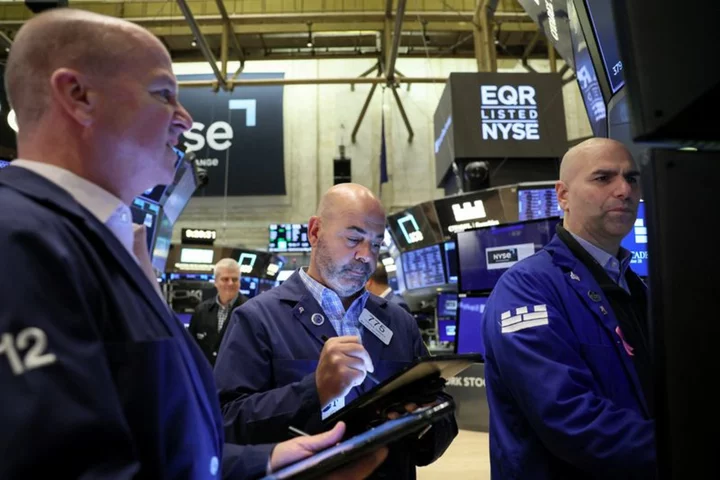By Kevin Yao and Ziyi Tang
BEIJING China's central bank is likely to cut lending rates further in a bid to revive the economy but reluctance among private firms and households to borrow means continued policy easing could end up hurting banks already battling margin pressures, analysts said.
Small cuts in rates will not have a big impact on demand for loans as families and businesses repair balance sheets damaged by COVID and repay debts, economists said, forcing Beijing to rely on fiscal stimulus and other policy tools to spur demand.
The People's Bank of China (PBOC) cut its benchmark loan prime rates (LPR) for the first time in 10 months on Tuesday, with a smaller-than-expected 10-basis point reduction in the five-year LPR, which influences the pricing of mortgages.
Most economists expect another modest 10 bps LPR cut in the second half - on top of a 25 bps cut in banks' requirement ratio (RRR). The PROC last cut the RRR - the amount of cash that banks must hold as reserves -- in March, by 25 bps.
To help create room for lending rate cuts, Beijing will have to let banks lower rates on deposits, a key source of funding for the lenders, with their net interest margins - a key gauge of profitability - at record lows.
Chinese banks' NIM shrank sharply from 1.91% at the end of last year to 1.74% last quarter.
"It is possible to see further LPR cuts in the second half of this year ... That will again bring cost pressure on banks," said Wang Yifeng, a banking sector analyst at Everbright Securities Co.
"I think banks are likely to take measures in the fourth quarter to control the costs of liabilities, such as further lower interest rates of some deposit products," Wang said. "Pressure on banks from narrowing NIM still persists."
Each 5 basis points LPR cut could reduce pre-tax profits of major banks by as much as 1.8%, China Merchants Securities said in a report.
But lowering of both lending and deposit rates will not help banks if demand for credit doesn't pick up.
A round of deposit rate cuts by banks since September have so far failed to spur consumption, and further cuts may be counterproductive as savers are hurt by weaker returns, analysts said.
New household loans, mainly mortgages and consumer loans, accounted for just 14% of total new loans in the first five months, down from 18% last year and 40% in 2021, while the bulk of new loans went to companies, central bank data showed.
"A small rate cut is a useful painkiller for symptoms but cannot alleviate the real problem," said Gary Ng, Asia Pacific senior economist of Natixis.
"Households and corporates are uncertain about the economic outlook and policy predictability. It means the government needs to untangle the knot on regulations and provide more breathing space beyond monetary and fiscal policies."
CONFIDENCE WEAKNESS
As private sector business confidence remains depressed, more credit could be channeled to state firms and infrastructure projects. However, that could in turn fuel bad debt risks in the banking sector and structural distortions, economists say.
"Credit demand for privately owned businesses has remained rather weak over the past few years since COVID," said an executive at a major state bank, who did not want to be identified as he was not authorised to speak to the media.
"And now that businesses are repairing their balance sheets after the COVID restrictions were ended (in December), it's unrealistic for them to borrow money to build up factories and expand capacity."
China remains on track to hit its modest 2023 growth target of around 5%, but a deeper slowdown in the coming months could stoke more job losses and fuel deflationary risks, further undermining private-sector confidence, economists said.
On Friday, China's cabinet discussed policy measures to support the economy. Policy insiders expect measures to be focused on quickening infrastructure spending, supporting consumer and private firms, and easing property sector curbs.
Beijing should quickly implement a package of economic policies to eliminate the output gap, which measures the difference between an economy's actual and potential output, said Zhang Ming, a senior economist at the Chinese Academy of Social Sciences, a top state think tank.
The central government should consider issuing 1 trillion yuan ($139 billion) in special bonds to fund consumer vouchers, Zhang said. The government has so far resisted such calls for aggressive measures, even though Beijing has pledged to prioritise a consumer recovery.
Despite significant growth headwinds, China, however, is unlikely to face a situation like Japan's economic crisis in the 1990s as there has not been a "big financial shock" in the world's No.2 economy, Morgan Stanley economists wrote in a report.
"We think that the cautionary lessons from Japan's experience in the 1990s have been well-documented and a repeat of it in China's context appears far less likely."
(Reporting by Kevin Yao and Ziyi Tang in Beijing; Graphics by Kripa Jayaram; Editing by Sumeet Chatterjee)









